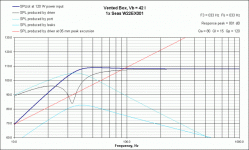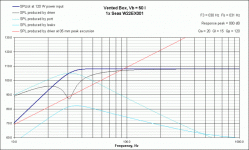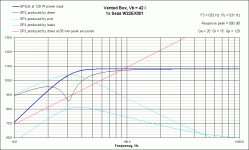I've just finished building Troel's Acapella SE
http://www.troelsgravesen.dk/diy_loudspeaker/The Acapella SE.pdf
Initially, there is quite a bit of mid-bass hum (or resonance) which makes double-bass and male voice sound kind of boomy. So I decided to put some stuffings right behind the driver and it helps a bit. There is still some left but it is much better now. On some recordings, this is not a problem but on some other recordings, I can feel it is very bothering.
My other problem is that the bass is a little lacking. I have to turn the volume all the way up to get deep and strong bass. The bass driver is an Seas 8in . The cabinet volume is about 42 liters. Is there any way I can boost the bass? My room is 14 x 20 feet. Can an 8in driver provide bass for this room size? the bass is a third order low pass that has no attenuation.
Also, I am suspecting the bass hum is due to internal standing wave. Do you know of a way to brace the cabinet to get rid of internal standing wave? I don't think my cabinet flex. I don't have any measurement equipment but when I place my ears right next to the cabinet walls (don't laugh), I really don't hear any hum. The hum comes right from the driver membrane.
If you look at the cross-over for the speaker, it uses a rather elaborate xover topology. Tweeter and mid uses 4th order with quite a few resistors too. I feel like the music lacks microdynamic. The 4th order certainly helps keep distortion in check but I think it robs the music of its inner beauty. For example, I don't feel the music as much as I did with the Living Voice speaker I used to have. Guitars don't quite have the sparkle that I expect. Ideally, you want some air and bloom around the instruments but I don't feel it here.
I'll email Troel about it. I'll post the picture once I can get a hold of a camera tomorrow.
http://www.troelsgravesen.dk/diy_loudspeaker/The Acapella SE.pdf
Initially, there is quite a bit of mid-bass hum (or resonance) which makes double-bass and male voice sound kind of boomy. So I decided to put some stuffings right behind the driver and it helps a bit. There is still some left but it is much better now. On some recordings, this is not a problem but on some other recordings, I can feel it is very bothering.
My other problem is that the bass is a little lacking. I have to turn the volume all the way up to get deep and strong bass. The bass driver is an Seas 8in . The cabinet volume is about 42 liters. Is there any way I can boost the bass? My room is 14 x 20 feet. Can an 8in driver provide bass for this room size? the bass is a third order low pass that has no attenuation.
Also, I am suspecting the bass hum is due to internal standing wave. Do you know of a way to brace the cabinet to get rid of internal standing wave? I don't think my cabinet flex. I don't have any measurement equipment but when I place my ears right next to the cabinet walls (don't laugh), I really don't hear any hum. The hum comes right from the driver membrane.
If you look at the cross-over for the speaker, it uses a rather elaborate xover topology. Tweeter and mid uses 4th order with quite a few resistors too. I feel like the music lacks microdynamic. The 4th order certainly helps keep distortion in check but I think it robs the music of its inner beauty. For example, I don't feel the music as much as I did with the Living Voice speaker I used to have. Guitars don't quite have the sparkle that I expect. Ideally, you want some air and bloom around the instruments but I don't feel it here.
I'll email Troel about it. I'll post the picture once I can get a hold of a camera tomorrow.
Here is the first version so far.
http://www.geocities.com/hai_vu1/AcapellaCab.JPG
Here is the rear view
http://www.geocities.com/hai_vu1/CabinetRear.jpg
Here is the inside of the cabinet. I think I made a mistake of not providing a couple of verticle braces. This may partly explain the standing wave at around the midbass which is causing a pronounce hum. I put some stuffing right behind the driver which helps quite a bit.
http://www.geocities.com/hai_vu1/RearNoStuffings.jpg
http://www.geocities.com/hai_vu1/AcapellaCab.JPG
Here is the rear view
http://www.geocities.com/hai_vu1/CabinetRear.jpg
Here is the inside of the cabinet. I think I made a mistake of not providing a couple of verticle braces. This may partly explain the standing wave at around the midbass which is causing a pronounce hum. I put some stuffing right behind the driver which helps quite a bit.
http://www.geocities.com/hai_vu1/RearNoStuffings.jpg
Hi Andy,
Just a quick question. Is this hum present when there is no music playing?? or is it just a fuzziness to the sound when playing music?
I'm wondering whether the problem is not with your speakers but with your amp, could be a case of the amp being fine with your old speakers but doesn't like these ones...... just a thought
Tony.
Just a quick question. Is this hum present when there is no music playing?? or is it just a fuzziness to the sound when playing music?
I'm wondering whether the problem is not with your speakers but with your amp, could be a case of the amp being fine with your old speakers but doesn't like these ones...... just a thought
Tony.
Hi Andy,
I just had a look at the original design and it looks like you have deviated from it quite a bit, Is the volume of your cabinet the same as the original cabinet??? what about the vent, from the picture of the back it looks like you have a very large hole in the back.
My guess would be that your cabinet tuning for the woofer is not correct.
you said that the cabinet volume is 42L, have you simulated this to see how the response curve looks?
Tony.
I just had a look at the original design and it looks like you have deviated from it quite a bit, Is the volume of your cabinet the same as the original cabinet??? what about the vent, from the picture of the back it looks like you have a very large hole in the back.
My guess would be that your cabinet tuning for the woofer is not correct.
you said that the cabinet volume is 42L, have you simulated this to see how the response curve looks?
Tony.
wintermute said:Hi Andy,
I just had a look at the original design and it looks like you have deviated from it quite a bit, Is the volume of your cabinet the same as the original cabinet??? what about the vent, from the picture of the back it looks like you have a very large hole in the back.
My guess would be that your cabinet tuning for the woofer is not correct.
you said that the cabinet volume is 42L, have you simulated this to see how the response curve looks?
Tony.
As for the port, it is a flare port with quite a large opening but the internal diameter is 3in. which is pretty close to 72mm indicated in the original design. The port lenght is about 220mm but the hum still there when I closed the port. I will try to shorten the port to about 180mm.
It's not really a hum but more like a pronounce upper midbass lift on certain recordings. On others, I really don't here it.
As for the cab volume, it is about 42L -- maybe a litter larger (about 44L) but not by much.
I don't have any simulation tools so anyone knows how the bass will sound if I make the cabinet a little smaller?
Don't try shortening the port, if anything it should be a bit longer.
I got the specs for your woofer from seas web site and modeled it in unibox. It's not too far off the mark, graph attached.
In the next post I will show what will happen if you shorten the port to 180mm
Tony.
I got the specs for your woofer from seas web site and modeled it in unibox. It's not too far off the mark, graph attached.
In the next post I will show what will happen if you shorten the port to 180mm
Tony.
Attachments
here is what happens when you reduce the port length to 180mm
note that the response peak goes up by another db.
Two things I can think of that may be giving you problems.
1. The close proximity to the rear of the driver of one of your braces. you may be getting reflections off it messing up the sound.
2. This is a rear ported design, if you have it too close to the wall you may be getting a bass boost. This may not be just because of the rear port, the speaker may have baffle step compensation in the crossover, and if so and you place it too close to the wall the compensation may be too much.
Tony.
note that the response peak goes up by another db.
Two things I can think of that may be giving you problems.
1. The close proximity to the rear of the driver of one of your braces. you may be getting reflections off it messing up the sound.
2. This is a rear ported design, if you have it too close to the wall you may be getting a bass boost. This may not be just because of the rear port, the speaker may have baffle step compensation in the crossover, and if so and you place it too close to the wall the compensation may be too much.
Tony.
Attachments
Hi Tony,
Thanks for the graphs. I thought that shorten the port in effect would reduce the Fb frequency therefore tighten up the bass.
Of course you probably know it better than I do.
As for your comment of the braces that might be causing the problem, I do see a lot of design with vertical brace right behind the driver so I figure it is not really a problem.
Do you think the side panel is the problem? They don't have any braces in themselves but I'll try putting a few on them.
Or do you think the cabinet is actually a little bigger than it should be?
Thanks for the graphs. I thought that shorten the port in effect would reduce the Fb frequency therefore tighten up the bass.
Of course you probably know it better than I do.
As for your comment of the braces that might be causing the problem, I do see a lot of design with vertical brace right behind the driver so I figure it is not really a problem.
Do you think the side panel is the problem? They don't have any braces in themselves but I'll try putting a few on them.
Or do you think the cabinet is actually a little bigger than it should be?
Well I'm only going off the modelling program but I think it is the other way around, shortening the port increases the box resonant frequency.....
I did a simulation in speaker workshop (quasi butterworth) to see what it thought was the best cabinet volume, it came in at about 50L (one of the things I don't like about unibox, is it won't necessarily recommend a good starting point).
Anyway I modeled it in unibox with at 50L and it looks a little better than 42L so if anything your box is a little smaller than optimal, reducing it further will not help IMO.... if you change the volume you will need to further change the port tuning as well, and will probably end up with a slightly higher F3.
here is the graph.
Tony.
I did a simulation in speaker workshop (quasi butterworth) to see what it thought was the best cabinet volume, it came in at about 50L (one of the things I don't like about unibox, is it won't necessarily recommend a good starting point).
Anyway I modeled it in unibox with at 50L and it looks a little better than 42L so if anything your box is a little smaller than optimal, reducing it further will not help IMO.... if you change the volume you will need to further change the port tuning as well, and will probably end up with a slightly higher F3.
here is the graph.
Tony.
Attachments
This one is a 42L box with 247mm port.
One other thing... are you only covering the sides and back of the enclosure?? Bass reflex normally aren't stuffed.
Also the modelled response using your volume of 42L and port diameter and length only has a response peak of about 1db, so I don't think that tuning of the box is the culprit as a 1db hump at the bottom end I don't think would be particularly noticable, and if anything should be making the lower bass stronger not weaker.
I'd try moving the speakers around the room a bit and see how they sound, try putting them at least 4 feet out from any wall. If you have them in a corner then you could be getting a big boost of certain bass frequencies (Others know much more about this than me)....
the only other thing I can think of is that maybe you have leaks in your cabinet, but I think they would have to be pretty severe to cause your problem..... can you run an impedance curve of the driver in the cabinet, that will allow you to work out what freq the box is actually tuned at.
Tony.
edit: ahhh just discovered I don't need to reduce the size anymore!! yay
One other thing... are you only covering the sides and back of the enclosure?? Bass reflex normally aren't stuffed.
Also the modelled response using your volume of 42L and port diameter and length only has a response peak of about 1db, so I don't think that tuning of the box is the culprit as a 1db hump at the bottom end I don't think would be particularly noticable, and if anything should be making the lower bass stronger not weaker.
I'd try moving the speakers around the room a bit and see how they sound, try putting them at least 4 feet out from any wall. If you have them in a corner then you could be getting a big boost of certain bass frequencies (Others know much more about this than me)....
the only other thing I can think of is that maybe you have leaks in your cabinet, but I think they would have to be pretty severe to cause your problem..... can you run an impedance curve of the driver in the cabinet, that will allow you to work out what freq the box is actually tuned at.
Tony.
edit: ahhh just discovered I don't need to reduce the size anymore!! yay
Attachments
well in unibox changing the parameter for leaks did cause the bass to droop a bit but not substantially... what I would suggest is getting some Polychloroprene sealing strip (recommended by someone here on diy Audio) and using it as a gasket, this is what I'm doing with my current prototype, though I left the front baffle removable...
I got mine from RS Australia... but you could probably use any weather strip.
here is a picture of my gasket. http://www.diyaudio.com/forums/attachment.php?s=&postid=563594&stamp=1107059001
worked for me... could tell the difference in the impedance curve once I put the gasket on, without it there was a big spike around 500Hz.
Tony.
I got mine from RS Australia... but you could probably use any weather strip.
here is a picture of my gasket. http://www.diyaudio.com/forums/attachment.php?s=&postid=563594&stamp=1107059001
worked for me... could tell the difference in the impedance curve once I put the gasket on, without it there was a big spike around 500Hz.
Tony.
- Status
- This old topic is closed. If you want to reopen this topic, contact a moderator using the "Report Post" button.
- Home
- Loudspeakers
- Multi-Way
- Fighting mid-bass hum



